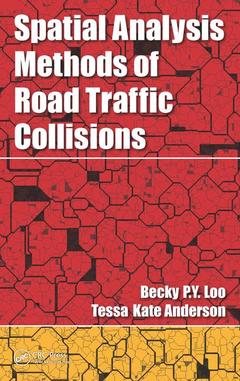Description
Spatial Analysis Methods of Road Traffic Collisions
Authors: Loo Becky P. Y., Anderson Tessa Kate
Language: English
Subjects for Spatial Analysis Methods of Road Traffic Collisions:
Keywords
Road Collision; Road Safety; Collision Frequency; Traffic Safety; Collision Risk; Road Accidents; Road Segment; Road Crashes; Road Traffic Injuries; Spatial Statistics; Collision Reduction; Injury Prevention; Road Environment; Geographic information system in transportation (GIST); Road Safety Measures; Speeding; EB Method; Drunk Driving; Action Plan; Drink Driving; Basic Spatial Unit; Engineering; Road Safety Problems; Enforcement; Child Pedestrian; Socially Sustainable Transport; Road Safety Strategy; Pedestrians; Road Safety Education; Public Health; Collision Patterns; GWR; Road Safety Analysis; Road Safety Literature; Collision Counts; Collision Density; Road Safety Engineering; Road Safety Campaigns; NEAREST NEIGHBOR
148.11 €
In Print (Delivery period: 15 days).
Add to cart· 15.6x23.4 cm · Hardback
Description
/li>Contents
/li>Readership
/li>Biography
/li>
Examine the Prevalence and Geography of Road Collisions
Spatial Analysis Methods of Road Traffic Collisions centers on the geographical nature of road crashes, and uses spatial methods to provide a greater understanding of the patterns and processes that cause them. Written by internationally known experts in the field of transport geography, the book outlines the key issues in identifying hazardous road locations (HRLs), considers current approaches used for reducing and preventing road traffic collisions, and outlines a strategy for improved road safety. The book covers spatial accuracy, validation, and other statistical issues, as well as link-attribute and event-based approaches, cluster identification, and risk exposure.
The book provides a brief summary of the evolution of road safety in the twentieth century, explores current road safety problems, and establishes road safety as a public health issue. The authors discuss risk and socioeconomic factors, lifestyle and behavior, and the impact of urban development. They consider road engineering, signage, vehicle design, the education of road users, and the enforcement of traffic safety measures. They also factor in the overall impact of road traffic collisions on transportation systems, economic systems, health systems, and society as a whole.
- Combines theoretical methodology with empirical data
- Bridges research and practice in road safety
- Includes case studies from around the world
Spatial Analysis Methods of Road Traffic Collisions takes a look at spatial methods and their role in analyzing road traffic collisions to improve road safety. A great addition to transportation safety practice and research, this book serves as a reference for spatial analysis researchers and postgraduate students in traffic and transportation engineering, transport, and urban transport planning.
Collisions as Spatial Events. Collision Density in Two-Dimensional Space. Road Safety as a Public Health Issue. Risk and Socioeconomic Factors. Road Collisions and Risk-Taking Behaviors. Road Collisions and Urban Development. Nature of Spatial Data, Accuracy, and Validation. Collisions in Networks. Cluster Identifications in Networks. Exposure Factor 1: Traffic Volume. Exposure Factor 2: Road Environment. Exposure Factor 3: Distance Traveled. Enforcement. Engineering. Education. Road Safety Strategy.
Becky P.Y. Loo is professor of geography and director of the Institute of Transport Studies at the University of Hong Kong. Her research interests are transportation, e-technologies, and society. In particular, she is interested in applying spatial analysis, surveys, and statistical methods in analyzing pertinent issues related to sustainable transportation. She is editor-in-chief of Travel Behaviour and Society and associate editor of the Journal of Transport Geography. She is also on the editorial boards of Asian Geographer, Injury Epidemiology, International Journal of Shipping and Logistics, International Journal of Sustainable Transportation, Journal of Urban Technology, and Transportmetrica A: Transport Science.
Tessa Kate Anderson is a researcher at the Technical University of Denmark in Copenhagen. She has previously worked at the University of Hong Kong, the University of Queensland, and the University of Canterbury. She completed her Ph.D at the Centre for Advanced Spatial Analysis in London. Her research interests are transportation, road safety, and socioeconomics. In particular, she is interested in the links between socioeconomics and road safety, the effects of climate change on road safety and transport, and the application of spatial analysis. She has published research papers in Accident Analysis and Prevention, Environment and Planning B, and Cities.




